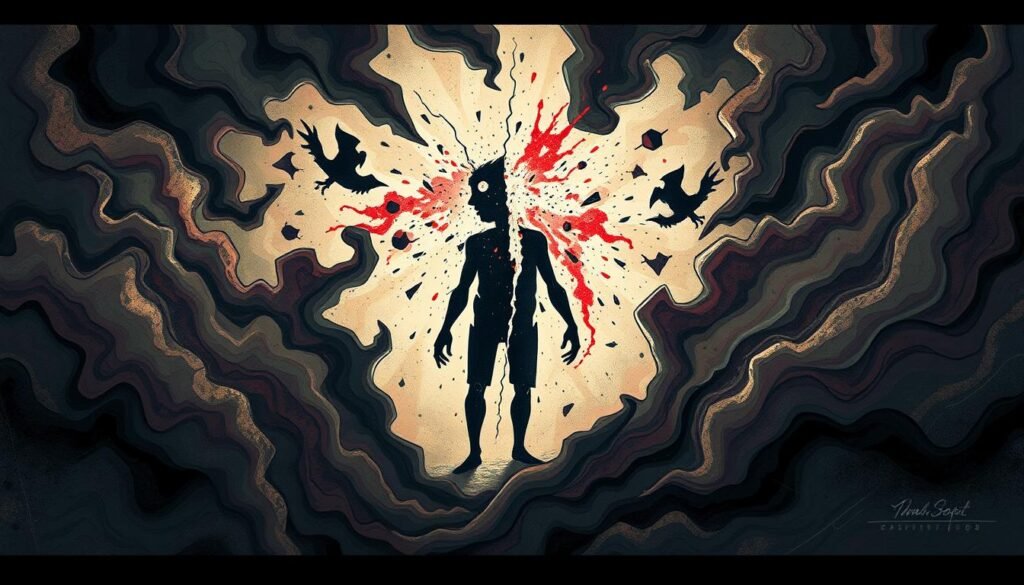Over 40 million adults in the U.S. suffer from anxiety. That’s about 19.1% of the population. Anxiety deeply affects lives, impacting work and relationships. Knowing the exact type of anxiety is key.
This could be generalized anxiety disorder, social anxiety, or specific phobias. Knowing your type helps choose the right treatment. This guide is here to help identify symptoms and find ways to get better. By understanding your anxiety, taking steps to recover becomes easier.
Key Takeaways
- Over 40 million adults in the U.S. experience anxiety disorders.
- Generalized anxiety disorder is the most common type of anxiety disorder.
- Social anxiety disorder primarily manifests in social settings.
- Panic attacks can occur for individuals experiencing anxiety disorders.
- OCD and PTSD significantly impact individuals’ daily lives.
- Anxiety disorders are manageable through therapy and lifestyle changes.
Understanding Anxiety: An Overview
Anxiety is a common emotion. It includes worry, unease, or fear, often due to daily stressors. The anxiety definition notes that it’s a protective mechanism. However, it can become overpowering and harmful. Nearly 1 in 5 American adults face anxiety yearly, showing it’s widespread.
What is Anxiety?
The anxiety overview shows that anxiety is normal but can be a problem. It becomes an issue when it affects day-to-day life. Symptoms can be physical and emotional, causing distress. People might worry excessively about regular events, affecting work, relationships, and happiness.
When does Anxiety Become a Disorder?
Knowing when anxiety turns into a disorder is crucial. Anxiety disorder criteria say it’s when fear or anxiety is extreme and lasting. For example, Generalized Anxiety Disorder affects almost 7 million in the U.S., with ongoing worry. Social Anxiety Disorder impacts about 15 million Americans, causing fear of social situations and significant difficulty.
Spotting these issues early and treating them is key. Cognitive Behavioral Therapy (CBT) is effective for many with anxiety disorders. It helps people face and handle their fears. For more details, check out anxiety disorders information.
Types of Anxiety Disorders
There are many kinds of anxiety disorders, each with its own signs. Knowing the types of anxiety disorders helps with proper treatment. Among the common ones are Generalized Anxiety Disorder (GAD), Panic Disorder, Social Anxiety Disorder, Phobias, Obsessive-Compulsive Disorder (OCD), and Post-Traumatic Stress Disorder (PTSD). Symptoms can range from ongoing worry to sudden, intense fear episodes.
Common Anxiety Disorders Explained
Several common anxiety conditions affect people:
- Generalized Anxiety Disorder (GAD): It means having constant and extreme worry.
- Panic Disorder: This involves sudden panic attacks that bring about great fear.
- Social Anxiety Disorder: It’s the fear of being in social settings, leading to avoiding them.
- Phobias: These are extreme fears that cause a lot of anxiety.
- Obsessive-Compulsive Disorder (OCD): This disorder includes unwanted thoughts and the need to perform rituals.
- Post-Traumatic Stress Disorder (PTSD): Traumatic events cause this, leading to flashbacks and avoiding reminders.
These disorders can deeply affect someone’s life. People may feel anxious all the time or have severe panic attacks. The effects of anxiety can make everyday life hard, hurt job performance, and damage relationships. Spotting these signs early is key for treatment.
Impact of Different Anxiety Disorders
The way these disorders affect people can vary. They might cause baseless fears, constant stress, and trouble with daily tasks. Often, past traumas, genetics, and other health issues play a role. Treatments might combine psychology and medicine. Cognitive-behavioral therapy (CBT) is usually very helpful.
What Kind of Anxiety Do I Have?
Knowing how to spot anxiety is the first step in figuring out the type you have. Many people feel anxious every day. But knowing exactly why can be hard. Using tools like the K10 questionnaire helps understand feelings from the last month. This helps people make smart choices about getting help.
Identifying Your Anxiety Symptoms
Anxiety shows up in many ways. It’s important to know the difference between normal worry and serious anxiety. People might worry a lot about things like health or money.
- Persistent worry about everyday issues like health, family, and finances.
- Physical reactions such as increased heart rate, sweating, or shortness of breath.
- Behavioral changes, including avoiding certain activities or social situations.
Looking into your anxiety helps understand your feelings. This includes knowing about gender differences and risk factors. Such info is key to getting the right care. It helps decide if therapy or medicine is needed.
Starting to deal with anxiety means thinking about your experiences. Using tools like the anxiety screening tools online helps a lot. These tools guide you to the right help.
Generalized Anxiety Disorder (GAD)
Generalized Anxiety Disorder, or GAD, involves constant worry about many parts of life. People with GAD struggle to manage their anxiety. This leads to symptoms that distress them. It’s important to know these symptoms to get help.
Symptoms of GAD
People with GAD may show different signs, including:
- Restlessness or feeling on edge
- Fatigue and difficulty concentrating
- Muscle tension
- Sleep disturbances
- Irritability
- Physical symptoms like headaches or gastrointestinal issues
Women tend to get GAD more than men. People who had tough or traumatic times, especially as kids, are more at risk. GAD can also overlap with other mental health issues, which makes treatment more complex.
How GAD Differs from Normal Anxiety
Anxiety and GAD differ mainly in how long and intense the worry is. Anxiety is a natural response to stress. But GAD involves long-lasting anxiety about many things. It affects how people function every day. This can make life really hard, harming relationships and jobs.
Doctors might use the GAD-7 questionnaire to diagnose GAD. Getting help early can make a big difference. If you wait, it could get harder to manage GAD and other related problems.

Social Anxiety Disorder
Social Anxiety Disorder is more than just being shy. It involves a deep fear of being in social situations. People fear being judged or watched by others. Understanding this condition is important because it’s not just shyness.
Understanding Social Anxiety
About 5% to 10% of people around the world have social anxiety. It’s the third most common mental issue, after substance use and depression. Females often experience it more than males. Most start feeling it before they turn 20.
It looks a lot like extreme shyness or avoiding social places. People worry for days before an event. They might skip it because they’re so anxious.
Symptoms and Triggers of Social Anxiety
Here are some symptoms of social anxiety:
- Blushing
- Sweating
- Rapid heart rate
- Nausea
- Difficulty making eye contact
These can get worse in social settings, sometimes leading to panic attacks. Knowing what triggers social anxiety is key. Triggers can lead to avoiding people and places, affecting one’s life deeply.
| Symptoms | Levels of Severity | Impact on Life |
|---|---|---|
| Blushing | Mild | May slightly affect social interactions |
| Sweating | Moderate | Affects education and career opportunities |
| Panic attacks | Extreme | Causes significant avoidance of social situations |
Getting help for social anxiety is very important. Treatments like Cognitive Behavioral Therapy (CBT) and medication can help. If not treated, it can lead to feeling very bad about oneself and isolation.
Panic Disorder and Panic Attacks
Panic Disorder happens when someone has sudden, intense fear that comes without warning. Around 2-3% of adults in the US are affected. Women are more likely to have it than men. It usually starts in the late teens or early adult years. Without treatment, it can get worse.

What is Panic Disorder?
Panic disorder means having many unexpected panic attacks. These episodes can include a racing heart, sweating, shaking, or feeling like you can’t breathe. People might feel like something awful is going to happen. It’s more common in people who have family members with the disorder or who have gone through big stress.
Recognizing Panic Attack Symptoms
Panic attacks can happen lots or just a few times. Knowing the symptoms is key. They are not the same as anxiety attacks because they come on suddenly and are very intense. An attack usually lasts from 5 to 20 minutes but the fear might stick around longer.
There are good treatments for panic disorder. Cognitive behavioral therapy (CBT) helps a lot. It teaches people to respond differently to their fear. Eating healthy and exercising can also help people feel better.
Phobias: Specific Fears
Phobias are an intense and irrational fear of certain objects or situations. They can cause a lot of stress. This makes some people avoid things that make them afraid. Knowing the difference between phobias and normal fears is key to getting help.
Understanding Phobias
About 19 million Americans struggle with phobias. These fears are different from other mental health issues. For instance, panic attacks can happen with phobias, unlike symptoms of schizophrenia. Phobias can cause fear in social settings or even at the dentist, showing how varied they are.
Common Types of Phobias
Phobias are grouped into five main types. This helps when looking for ways to treat them:
- Situational Type: Fears related to specific situations such as flying, heights, or enclosed spaces.
- Natural Environment Type: Fears about nature, like thunderstorms or heights.
- Blood-Injury-Injection Type: Fears about medical things, like needles or seeing blood.
- Animal Type: Fears of certain animals, like snakes or spiders.
- Other Type: Unique fears, like clowns or vomiting.
Studies show women are more likely to fear animals. Kids and those with less money often have social or situational phobias. Cognitive behavioral therapy (CBT) is a great way to treat these fears, especially with virtual reality help. For many, the best way to manage phobias is with both medicine and therapy.
Obsessive-Compulsive Disorder (OCD)
Obsessive-Compulsive Disorder is a mental illness defined by unwanted thoughts and actions. People often confuse OCD with just being quirky, but it really messes with someone’s life. Knowing about OCD is really important for those dealing with it and their close ones.
What is OCD?
OCD usually starts in the teens or early adulthood, but it can kick in during childhood too. The hallmarks of this disorder are obsessions—these are persistent thoughts that cause a lot of worry. To try and calm these worries, someone with OCD will turn to certain rituals or behaviors.
These rituals might range from mild to really intense. They tend to get worse when someone is stressed or going through changes. The risk of having OCD is higher if family members have it, making it something that might always be a part of one’s life.
Common Obsessive and Compulsive Behaviors
OCD symptoms show up as various rituals designed to lower stress from obsessive thoughts. Some typical rituals include:
- Excessive hand washing or cleaning
- Checking locks and appliances over and over
- Organizing things in a very specific manner
- Staying away from places seen as risky
- Constantly reassuring oneself about potential dangers, like germs
These actions can take up a lot of time, more than an hour each day. This leads to issues like relationship trouble, a drop in life quality, and health problems like contact dermatitis. Recognizing these signs and their effects on someone’s life and work is key.

| OCD Symptoms | Impact on Life |
|---|---|
| Obsessive thoughts (e.g., fears of contamination or harming others) | May lead to isolation or avoiding hanging out with friends |
| Compulsive rituals (e.g., checking, hand washing) | Makes it hard to keep up with work and daily tasks |
| High anxiety during times of stress | OCD symptoms get worse during big life changes |
| Family history of OCD | Makes it more likely for you to get OCD |
OCD needs compassion, proper treatment like therapy, and sometimes medicine. By staying informed and supportive, those affected can tread a path toward managing their condition.
Post-Traumatic Stress Disorder (PTSD)
PTSD, or Post-Traumatic Stress Disorder, deeply affects people after they face a traumatic event. Around 6 in every 100 people will deal with it sometime in their life. Knowing about the different PTSD symptoms is vital. These symptoms vary per person and may change over time.
Understanding PTSD
PTSD symptoms usually start within three months of the trauma but sometimes appear years later. Events like combat, childhood abuse, sexual violence, and assault can cause PTSD. More women than men tend to develop this condition.
People with PTSD often relive their trauma, have nightmares, and feel more anxious. They might avoid things that remind them of the trauma. This affects schooling, work, relationships, and enjoying life.
Kids under six might act out the trauma or start bedwetting again. Understanding the effects of trauma helps in giving the right support and treatment.
Depression and substance use can also occur with PTSD. Having social support and a positive family background can make things better. Yet, past traumas and little support increase the risk of PTSD.
PTSD treatments include therapy, meds, or both. Therapy can be one-on-one or in groups, taking six to twelve weeks. Methods like facing fears and changing thoughts are used.
With the right support and treatments, those with PTSD can manage their symptoms. Knowing more about PTSD helps start the journey to recovery. This ensures people get the help they need.
| PTSD Statistics | Details |
|---|---|
| Prevalence | 6 out of 100 people will experience PTSD |
| Gender Disparity | Women are more likely to develop PTSD than men |
| Symptom Onset | Symptoms usually begin within 3 months of the traumatic event |
| Co-occurring Conditions | Depression, substance use, or anxiety disorders |
| Child Symptoms | Bedwetting or reenacting trauma through play |
Conclusion
Understanding and identifying anxiety disorders is key for getting the right help. In the United States, nearly 40 million people deal with these disorders. But, only a few get the treatment they need. This shows how important it is to spread knowledge about mental health help.
Seeking help through therapy, medication, or both can greatly improve one’s condition. Using coping methods like deep breathing, mindfulness, and exercise can also help with anxiety. These strategies, along with learning about mental health, can boost one’s well-being. For those wanting to spot anxiety’s physical signs early, checking out resources like how to recognize the warning signals is key.
Tackling anxiety isn’t just about finding treatment. It’s also about creating a community that supports and understands. By using the right resources and support, dealing with anxiety becomes easier. This journey is complex, but with the right help, one can face the challenges more effectively.